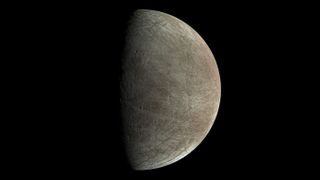These eerie sounds made from a NASA flyby of Jupiter's moon Europa are haunting
An eerie new video allows us to hear what NASA's Juno spacecraft experienced as it made a flyby of Jupiter's icy moon Europa last month.
The 11-second-long audio track expresses variations of plasma frequency, using data collected by Juno over 90 minutes as it made a flyby of Europa on Sept. 29. Converting this data into sound — data sonification — allows us to hear the variation of frequency of the plasma waves observed by Juno near Europa as the plasma density changes.
The plasma wave detections were made by the Juno Waves instrument in the frequency range of 50 to 150 kHz and the data collected during the flyby will help reveal more about Europa, according to a NASA statement.
Related: Behold! Our closest view of Jupiter's ocean moon Europa in 22 years

The Waves instrument was designed to help scientists understand the interactions between Jupiter's atmosphere, magnetic field and magnetosphere, as well as to understand Jupiter's auroras.
But it can also be useful for learning more about Europa, which scientists think has a large subsurface ocean. Measuring the changes in density of charged particle gas, or plasma, surrounding Europa can provide insight into the moon's magnetic field and, in turn, clues about the structure of the moon's interior.
The emissions reveal that plasma density near Europa ranged from about 60 to 120 electrons per cubic centimeter, but with a very brief peak near 300 electrons per cubic centimeter right at Juno's closest approach to Europa, according to NASA.
Get the Space.com Newsletter
Breaking space news, the latest updates on rocket launches, skywatching events and more!
Juno entered orbit around Jupiter in July 2016. The flyby is part of an extended mission that began in 2021. Juno made a flyby of Ganymede in June 2021 for which NASA also created a cool audio clip.
Juno will also fly by the volcanically active Io, the closest-in of the Galilean moons, in late 2023 and early 2024 as Jupiter's immense gravity pulls Juno closer to the planet with each orbit of the spacecraft.
Follow us on Twitter @Spacedotcom and on Facebook.
Join our Space Forums to keep talking space on the latest missions, night sky and more! And if you have a news tip, correction or comment, let us know at: community@space.com.

Andrew is a freelance space journalist with a focus on reporting on China's rapidly growing space sector. He began writing for Space.com in 2019 and writes for SpaceNews, IEEE Spectrum, National Geographic, Sky & Telescope, New Scientist and others. Andrew first caught the space bug when, as a youngster, he saw Voyager images of other worlds in our solar system for the first time. Away from space, Andrew enjoys trail running in the forests of Finland. You can follow him on Twitter @AJ_FI.
